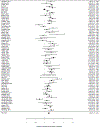Fatigue severity and avoidance among individuals with chronic disease: A meta-analysis
- PMID: 35665612
- PMCID: PMC9629285
- DOI: 10.1016/j.jpsychores.2022.110951
Fatigue severity and avoidance among individuals with chronic disease: A meta-analysis
Abstract
Objective: Fatigue is a common, debilitating symptom experienced by individuals with chronic disease. Avoidance, or the act of evading unwanted experiences, is associated with fatigue across chronic disease samples. The current study sought to determine the strength of association between fatigue severity and avoidance in individuals with chronic disease.
Methods: PubMed, PsycINFO, CINAHL, and ProQuest Dissertations and Theses databases were searched. Eligible studies measured fatigue and avoidance in chronic disease samples. Sixty-six studies were included. Data analyses were conducted in Rstudio. A random effects model was employed, and a weighted mean effect size was computed for fatigue severity and avoidance. Mixed-effects meta-regression analyses were conducted to examine moderating variables, including patient, clinical, and measurement characteristics. Publication bias was examined using funnel plot, trim-and-fill, and p-curve.
Results: The meta-analysis comprised of 71 unique patient samples from 66 studies. The total number of included participants was 13,024. A small, positive association was found between fatigue severity and avoidance, r(71) = 0.22, p < .001, 95% CI [0.18-0.27], SE = 0.02. There was also significant heterogeneity, Q(70) = 349.96, p < .001. Moderator analyses examining age, sex, illness duration, avoidance type, and disease sample were all non-significant. Regarding publication bias, trim-and-fill resulted in a modified weighted mean effect size (r(83) = 0.18, p < .001) and a p-curve analysis supported the evidential value of the current analysis.
Conclusion: Findings support that among individuals with chronic disease, fatigue severity and avoidance are positively associated, which has implications for behavioral interventions in this population.
Keywords: Avoidance; Chronic disease; Fatigue; Transdiagnostic processes; meta-analysis.
Copyright © 2022 Elsevier Inc. All rights reserved.
Conflict of interest statement
Figures
References
-
- Cella D, Riley W, Stone A, Rothrock N, Reeve B, Yount S, Amtmann D, Bode R, Buysse D, Choi S, The Patient-Reported Outcomes Measurement Information System (PROMIS) developed and tested its first wave of adult self-reported health outcome item banks: 2005–2008, J Clin Epidemio. 63(11) (2010) 1179–1194. 10.1016/j.jclinepi.2010.04.011. - DOI - PMC - PubMed
-
- Herdman TH, Nursing Diagnoses 2012–14: Definitions and Classification, John Wiley & Sons, Ames, 2012.
Publication types
MeSH terms
Grants and funding
LinkOut - more resources
Full Text Sources
Medical





